Need
to make the most of your time on social media? These tools are the best
of the best for social media management, planning and posting.
And if you’re completely crazy you may also be on YouTube, Periscope, Ello, Vimeo, and Snapchat.
That’s a lot of social media to manage. How the heck can you possibly be effective with all of that?
Well, the truth is most people are not effective with it. Mostly because they don’t have a strategy in place— but that’s another blog post altogether. I want to give you my insight on the best social media management tools to help you streamline your planning, scheduling, and posting.
Social Media Management Tools
I’ve used dozens of social media management tools over the years and there are plenty of lackluster, come-and-go tools that are just a waste of time and energy. I’m not going to waste your time on every tool available. I don’t find that kind of “all the things” post helpful.Because there are many categories of social media apps and tools that accomplish a wide range of things like analysis, curation, artificial intelligence, and other super-cool jobs to help you do more with less effort, I’m going to narrow things down. I’m going to be limiting this post to the “Publishing” category of tools that help you with specific tasks such as:
- Planning social media posts
- Scheduling social media posts
- Posting to your social media accounts
Buffer
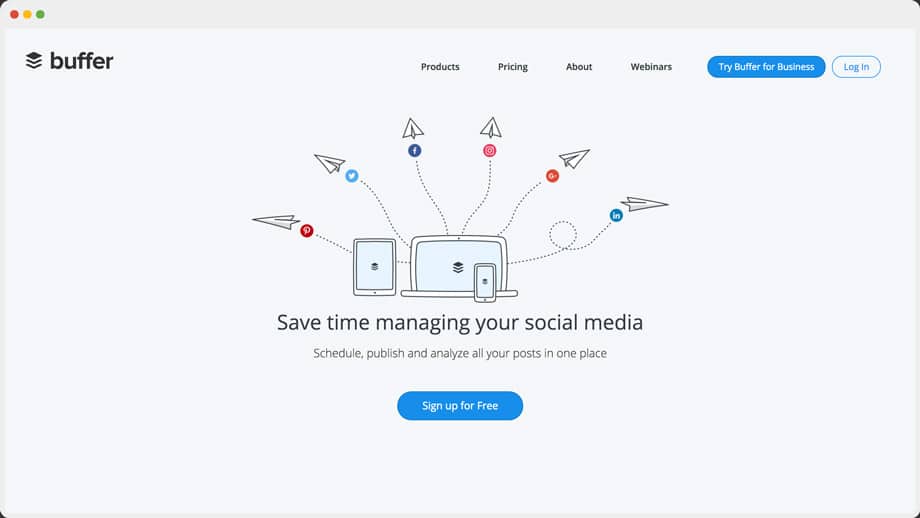
My number one, go-to social media management tool of choice is Buffer. Hands down. I could stop the blog post right here and just leave it at that.
Buffer is primarily a web app that allows you schedule and share social media posts to your pages and profiles. The network channels it currently supports are:
- Facebook (profiles, pages, and groups)
- Google+ (profiles and pages)
- LinkedIn (profiles and pages)
- Twitter profiles
- Pinterest profiles
- Instagram profiles
And let me just say, as someone who lives inside digital apps and interfaces all day long, UI/UX is one of the biggest selling points for me. If I don’t love using and interacting with the interface, I won’t do it. SaaS companies should take that to heart.
Using Buffer you can schedule posts to your social networks one at a time or simultaneously. This is a big help for those of us managing multiple accounts and brands.
Additionally, they have a browser extension that makes sharing any web page super easy.
Nearly all of the tools listed in this article have browser extensions, but Buffer seems to have perfected the workflow and execution of theirs while the others seem to be a bit more cumbersome, especially if you’re managing multiple social media channels and want to customize your messages for each one.
If you are a Buffer user and you’re not using the browser extension, I don’t know what you’re doing with your life. Get it!
They also have great smartphone apps for both iOS and Android for scheduling on the go.
On top of its powerful scheduling tools, Buffer also has some incredibly powerful analytics that will allow you to keep track of key social growth metrics.
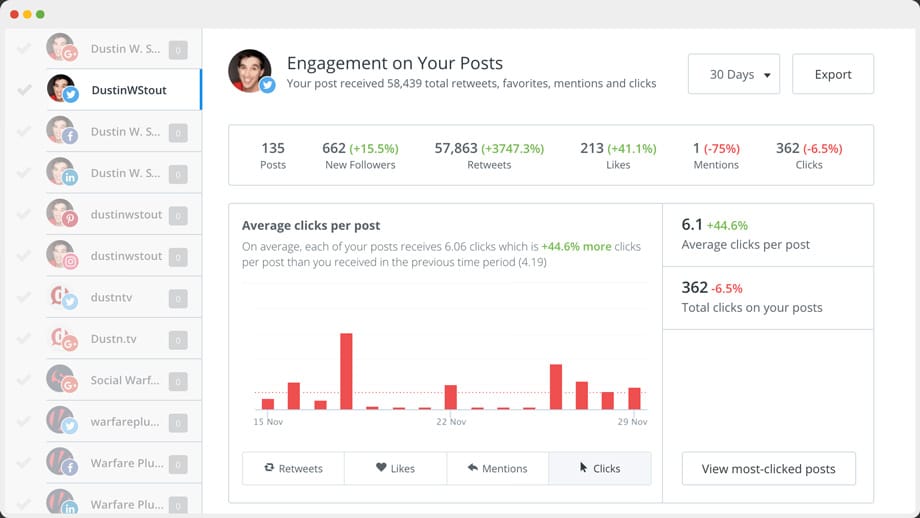
Additionally, Buffer gives you another feature called Content Inbox where you can add your favorite RSS feeds. This means that any time a new blog post is published to the feeds you are following, they will appear in this section for easy viewing and sharing to your Buffer queue.
The last thing I’ll note about Buffer is that it also has collaborative capabilities. So, if you’re working with a team and have multiple team members working on the same account contributing content, you’ll love their team features.
Buffer allows you to manage team members with specific roles (Content Contributor or Content Manager). The account owner and Content Managers have the ability to publish posts at any time while the Content Contributor’s posts get added to a For Review tab where they need to be approved before getting added to the queue.
Now, the downfall of Buffer as a full social media management solution is that they don’t have the ability to be an “inbox” of where you can easily see all your notifications or brand mentions within the app.
Buffer is simply a scheduling and analytics tool for social media managers.
However, Buffer has recently gotten into the social inbox game with their new tool, Respond. Since it’s a separate app, I don’t find myself using it much as it’s one more thing to log into. As crazy as it sounds, I actually prefer doing my engagement and responding in the native social network interfaces.
All around, Buffer allows me to perform the most arduous part of maintaining a consistent social presence across multiple accounts, networks and brands—that is the scheduling of content. And it does so in the most beautiful and seamless way possible.
Visit Buffer
CoSchedule

I’ve talked before about how great CoSchedule is as a content marketing calendar. I’ve even written extensively about why it is a non-negotiable tool for our team at Warfare Plugins. But even if you didn’t need it for this purpose it also works as a fantastic social media management calendar!
You can connect the same social channels as you can with Buffer but with the addition of one more (Tumblr):
- Facebook (profiles, pages, and groups)
- Twitter profiles
- LinkedIn (profiles and pages)
- Google+ pages (Powered by Buffer)
- Pinterest profile
- Instagram profile
- Tumblr blog
It’s also worth noting that if you are a Buffer user as well, you can connect your accounts so that scheduling in CoSchedule will add to your Buffer queues. For someone like me who likes to keep everything in one place as much as possible, this is super cool.
Their user interface is also beautiful and lays everything out on a calendar interface so you can see the exact distribution of your posts.
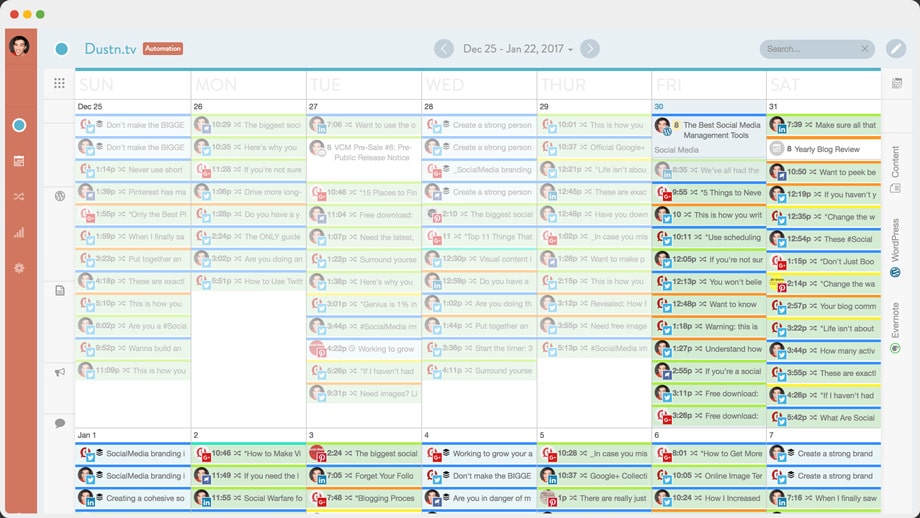
You have the ability to color-code your scheduled posts as well. This makes it possible to decide which colors represent certain types of content you are sharing so you can be sure you’re getting a good mix going.
The big bonus here is that CoSchedule also connects to WordPress and if you’re using a tool to schedule your own content on social media, you have direct access to it right from within the app.
And now with CoSchedules new Social Templates and ReQueue features, you can bet that this may soon be the one social media management tool to rule them all—especially for those who have WordPress blogs.
I’d be remiss if I didn’t mention briefly what those two features do.
Social Templates allow you create a templated sharing schedule for all your social networks when you have a new piece of content to share. Using their Social Helpers you can instantly populate an unlimited number of pre-scheduled messages with placeholders.
ReQueue is basically the best thing that’s happened to my social media management in a long time. You can mark any post you share through CoSchedule to be added to your ReQueue and CoSchedule will automagically repromote your best posts on a recurring basis, finding the best timing and spacing (so as to not be sharing the same things too frequently).
This makes your evergreen content take on a life of its own.
Visit CoSchedule
Sprout Social

When it comes to enterprise-level social media management, Sprout Social is a favorite. When you dive into the laundry list of features that are offered, you can quickly see why it is far more attractive to enterprises.
The networks supported include:
- Facebook (profiles and pages)
- Google+ pages
- Twitter profiles
- Instagram profiles
- LinkedIn (profiles and pages)
The ability to assign tasks and collaborate inside of the Sprout Social dashboard really makes it the most comprehensive and easy-to-use tool for teams.
Like CoSchedule, you also have the ability to see everything in a calendar view and tag social posts with certain categories. You can then easily see what your spread of messages and message categories are at a glance.
When it comes to content curation, like Buffer’s Content Inbox, Sprout has an RSS integration that allows you to connect your Feedly account. This means if you’re utilizing Feedly as a content curation tool, you can now pull it right into your social media management dashboard and do it all from one place.

Sprouts analytics tools are a big allure for many social media marketers because they’re beautifully designed and easy to export presentation-ready reports.
Seriously, these reports are gorgeous.

Their reports can also integrate with Google Analytics, making their reporting and analytics product second to none, in my humble opinion.
The scope of what Sprout Social is capable of can be truly daunting. It does so much that your head will spin trying to take it all in.
This is why I wouldn’t recommend Sprout for the newbie. However, if you’re a seasoned social media pro and you’re working with a team, it’s definitely worth looking into.
Visit Sprout Social
Friends+Me

For the Google+ power users out there, there is no better social media posting tool than Friends+Me. The reason for this is because it was a tool built for Google+ first, with all other networks as the secondary.
Unlike any other social sharing/management app, Friends+Me is the only tool on the market (that I’m aware of) that allows you to post to Google+ in every different way possible:
- Profiles
- Pages
- Collections
- Communities
If you’re a heavy Google+ user, there’s no better tool.
It also has the ability to connect and post to other social networks:
- Facebook (Profiles, Pages, Groups)
- LinkedIn (Profiles, Pages)
- Pinterest boards
- Tumblr
For example, if you wanted to just post to Google+ and have those posts automatically cross-posted to your other social accounts, you can set up a number of rules and hashtag triggers to make that happen.
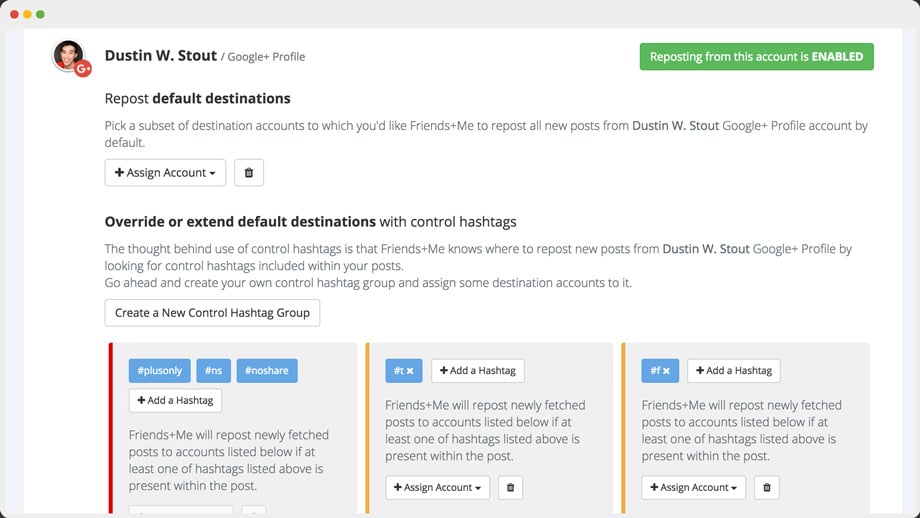
I’ve had the pleasure of seeing this app from its early days and have seen the founder, Alois Belska, do amazing things with it. It’s super cool to see this indy app become such a powerhouse tool.
Visit Friends+Me
Hootsuite
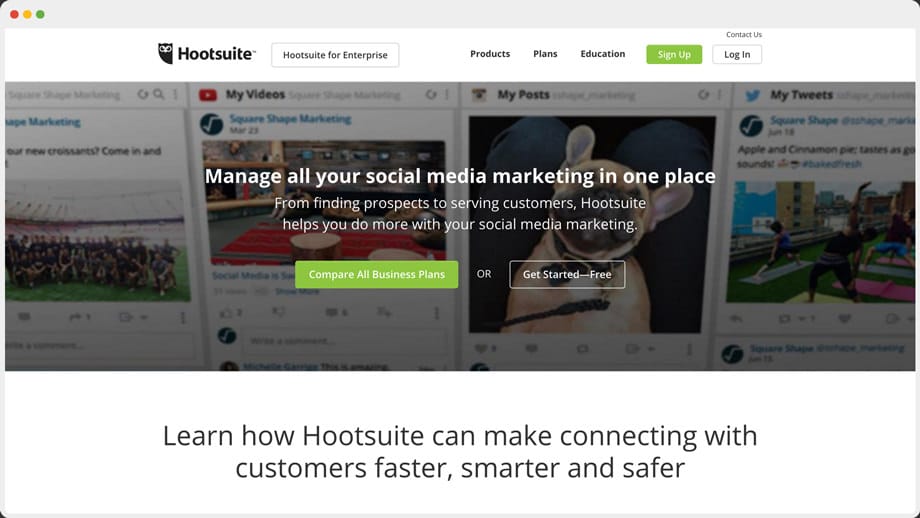
Although Hootsuite was one of the first big social media management tools on the market it has not been a part of my workflow for years. While it covers a handful of important social media management tasks and desirable features, they’ve sorely lacked the ability to execute on a good user experience.
As I mentioned above, if a user interface isn’t pleasant to use, I’m not going to use it. This is the biggest reason I’ve not interacted with Hootsuite in years.
However, it still continues to be a go-to tool for many professionals, and there’s good reason why.
Like many other tools previously mentioned, it supports all the most crucial social channels:
- Twitter profiles
- Facebook (profiles, pages, and groups)
- Google+ (profiles and pages)
- LinkedIn (profiles, groups, and companies)
- WordPress.com Blogs
- Instagram profiles
- YouTube channels
With Hootsuite the big draw is that it serves as both publishing tool and central hub for monitoring and replying to social mentions and comments.
Their streams view allows you to create columns that feed in your social streams from different networks.
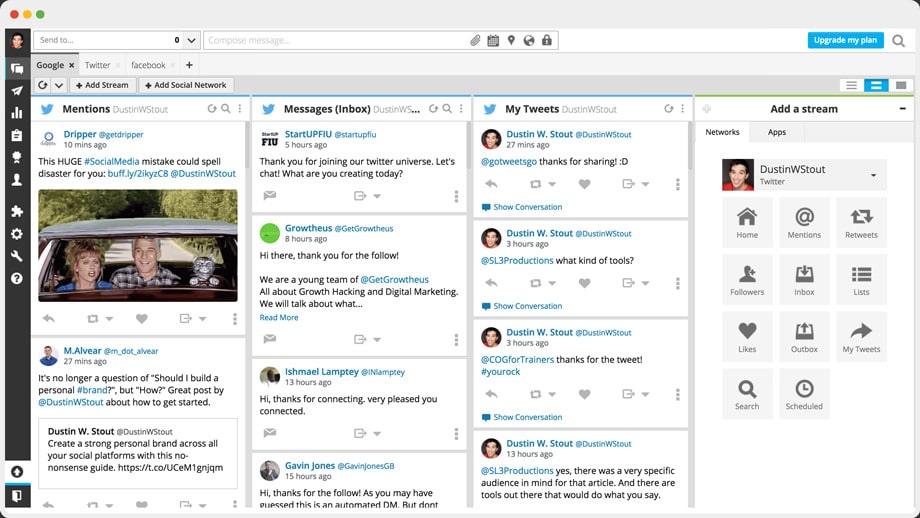
For the people who love Hootsuite, the streams seem to be the primary reason for their use. You can create streams for a number of things you want to monitor such as mentions, comments, your own posts, your scheduled posts, specific search terms on a given social network, and much more.
Visit Hootsuite
Specialty Social Media Management Tools
I’ve categorized the following apps and tools under “Specialty” because they have a more limited focus or are limited in the social networks they can help manage.Post Planner

Now, Post Planner is probably the most unique of all the tools on this list. While it is limited to only being able to manage Twitter (profiles) and Facebook (profiles, pages, groups) the real value it adds is in the area of helping you find and post the best possible content.
The folks at Post Planner have been digging through Facebook and Twitter’s most successful posts and creating a system for discovering and ranking content.
They then give you the ability to take advantage of their data and share posts that have proven to generate the most traction.
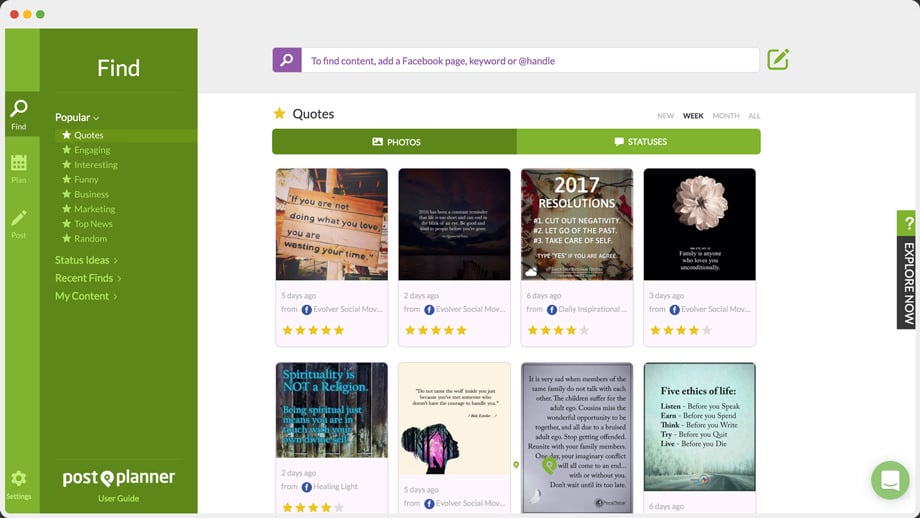
Like Buffer, you can create a schedule and add posts to your Plan (what Buffer calls a queue) and have them automatically go out according to that predetermined schedule.
You can also create multiple plans and assign specific types of content–links, images, and text posts–to each plan.
If content curation is a heavy emphasis for you and you would like some help in discovering the most popular/successful content to curate, Post Planner is definitely the tool you want in your arsenal.
Visit PostPlanner
TweetDeck
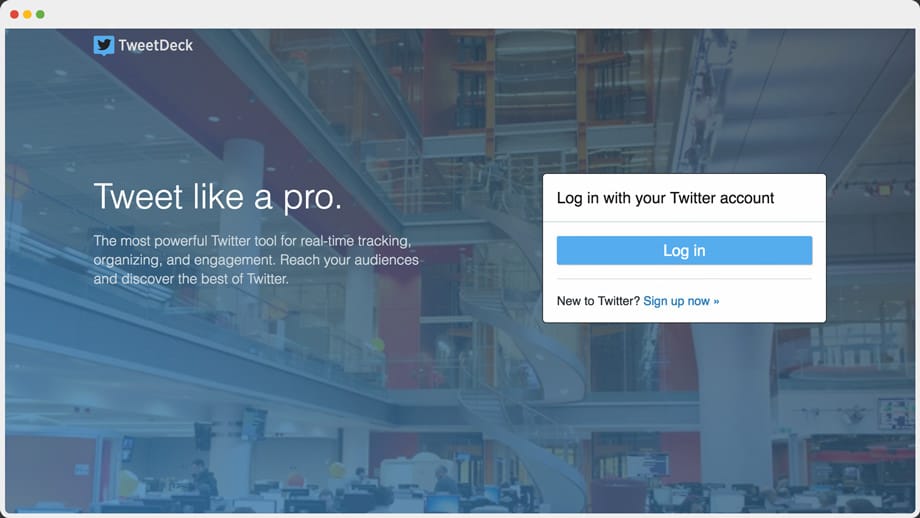
If you like the idea of having multiple streams of social media messages all in one view but only for Twitter–TweetDeck is probably a good tool for you.
This app is owned by Twitter and allows you to easily manage multiple Twitter accounts from one app. You can monitor and reply to mentions and messages as any of your connected profiles. You can also schedule posts to be tweeted at specific times.
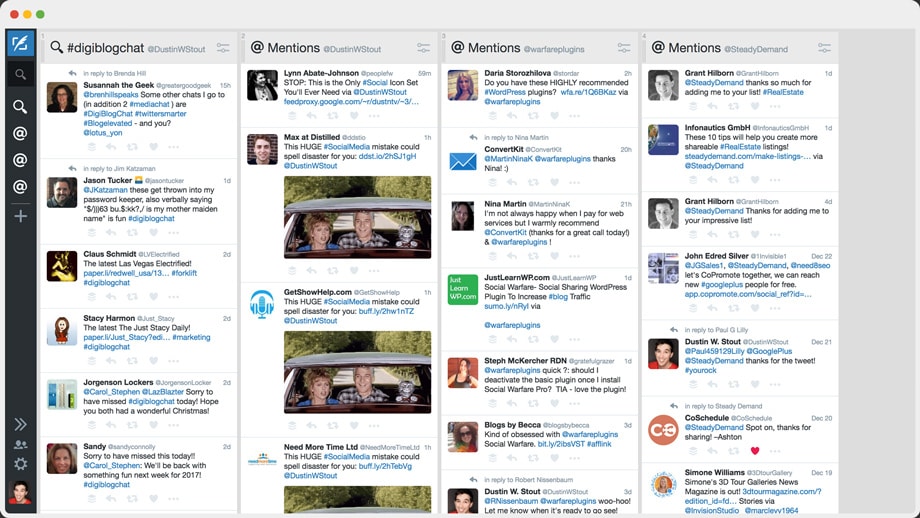
Personally, I like using TweetDeck for Twitter Chats because you can create a stream for the chat’s hashtag and have it right next to a stream of your @mentions to make sure you don’t miss out on anything important.
Visit TweetDeck
Tailwind

If you have a strong emphasis on Pinterest (which I highly encourage) then you will want to add Tailwind to your social media toolbox. Their tool is second to none when it comes to gaining insights as well as creating, curating, scheduling and posting content on Pinterest.
They are also testing beta integration with Instagram.
But the real power in this tool is the ability to deliver high-level Pinterest analytics, pull in pins that others have posted from your domain, and perform actions based on these things.
It really is a power-house Pinterest tool.
Now, I will say that the user interface could use some serious work. But if you’re not overly sensitive (like I am) to UI, then you won’t even notice it because the utility it provides is overwhelmingly good.
Visit Tailwind
The Right Tool for the Job
Social media management can be a difficult task. Having tools help, but having the right tools for the right job will make a world of difference.Hopefully, you’ve found a few here that will help you in your efforts to streamline your social media efforts.
Which social media management tool is your favorite? Did I leave yours out? You can leave a comment by clicking here.


No comments:
Post a Comment